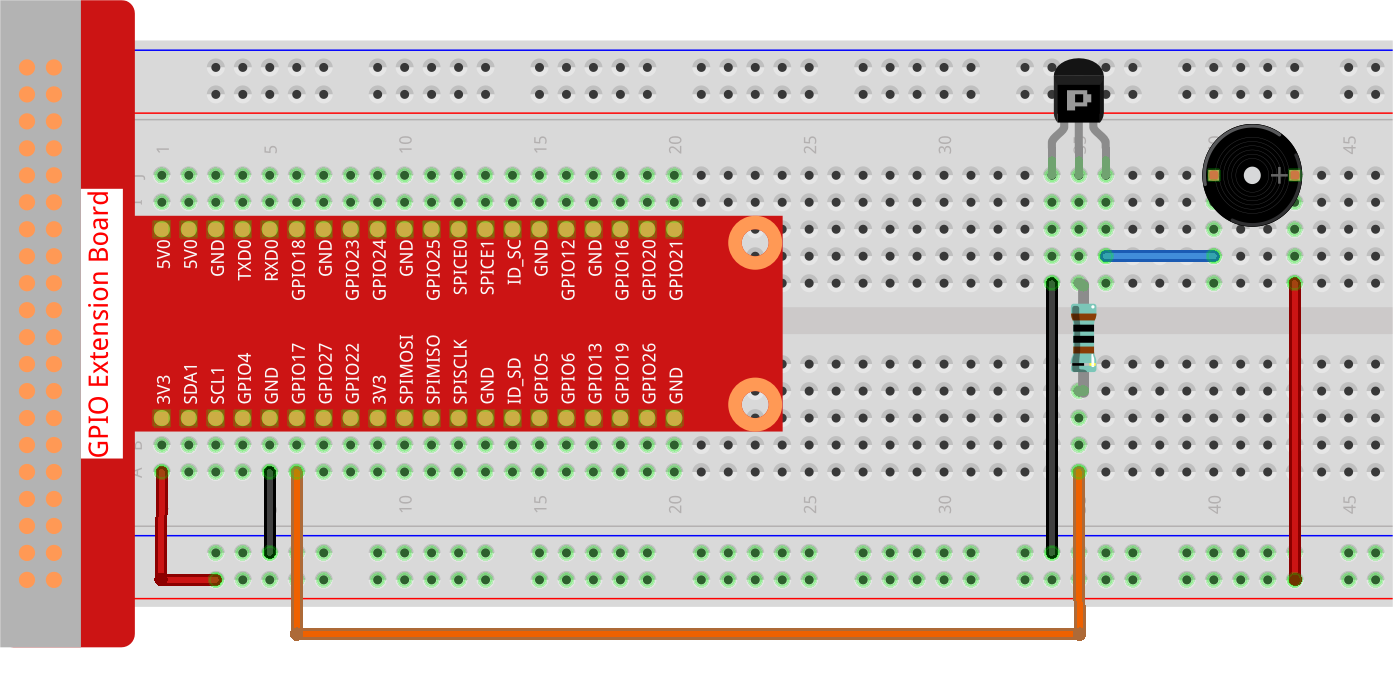1.2.2 Passive Buzzer¶
Introduction¶
In this project, we will learn how to make a passive buzzer play music.
Required Components¶
In this project, we need the following components.

Schematic Diagram¶
In this experiment, a passive buzzer, a PNP transistor and a 1k resistor are used between the base of the transistor and GPIO to protect the transistor.
When GPIO17 is given different frequencies, the passive buzzer will emit different sounds; in this way, the buzzer plays music.
T-Board Name |
physical |
wiringPi |
BCM |
GPIO17 |
Pin 11 |
0 |
17 |

Experimental Procedures¶
Step 1: Build the circuit. (The Passive buzzer with green circuit board on the back.)

Step 2: Change directory.
cd ~/davinci-kit-for-raspberry-pi/python-pi5
Step 3: Run.
sudo python3 1.2.2_PassiveBuzzer_zero.py
The code run, the buzzer plays a piece of music.
Code
Note
You can Modify/Reset/Copy/Run/Stop the code below. But before that, you need to go to source code path like davinci-kit-for-raspberry-pi/python-pi5. After modifying the code, you can run it directly to see the effect.
#!/usr/bin/env python3
from gpiozero import TonalBuzzer
from time import sleep
# Initialize a TonalBuzzer connected to GPIO pin 17
tb = TonalBuzzer(17) # Update this pin number based on your setup
def play(tune):
"""
Play a musical tune using the buzzer.
:param tune: List of tuples (note, duration), where each tuple represents a note and its duration.
"""
for note, duration in tune:
print(note) # Output the current note being played
tb.play(note) # Play the note on the buzzer
sleep(float(duration)) # Delay for the duration of the note
tb.stop() # Stop playing after the tune is complete
# Define a musical tune as a sequence of notes and durations
tune = [('C#4', 0.2), ('D4', 0.2), (None, 0.2),
('Eb4', 0.2), ('E4', 0.2), (None, 0.6),
('F#4', 0.2), ('G4', 0.2), (None, 0.6),
('Eb4', 0.2), ('E4', 0.2), (None, 0.2),
('F#4', 0.2), ('G4', 0.2), (None, 0.2),
('C4', 0.2), ('B4', 0.2), (None, 0.2),
('F#4', 0.2), ('G4', 0.2), (None, 0.2),
('B4', 0.2), ('Bb4', 0.5), (None, 0.6),
('A4', 0.2), ('G4', 0.2), ('E4', 0.2),
('D4', 0.2), ('E4', 0.2)]
try:
play(tune) # Execute the play function to start playing the tune
except KeyboardInterrupt:
# Handle KeyboardInterrupt for graceful termination
pass
Code Explanation
These lines import the
TonalBuzzerclass from thegpiozerolibrary for buzzer control and thesleepfunction from thetimemodule for creating delays.#!/usr/bin/env python3 from gpiozero import TonalBuzzer from time import sleep
This line initializes a
TonalBuzzerobject on GPIO pin 17.# Initialize a TonalBuzzer connected to GPIO pin 17 tb = TonalBuzzer(17) # Update this pin number based on your setup
The
playfunction iterates over a list of tuples representing musical notes and their durations. Each note is played for its specified duration, and the buzzer stops after completing the tune.def play(tune): """ Play a musical tune using the buzzer. :param tune: List of tuples (note, duration), where each tuple represents a note and its duration. """ for note, duration in tune: print(note) # Output the current note being played tb.play(note) # Play the note on the buzzer sleep(float(duration)) # Delay for the duration of the note tb.stop() # Stop playing after the tune is complete
The tune is defined as a sequence of notes (frequency) and durations (seconds).
# Define a musical tune as a sequence of notes and durations tune = [('C#4', 0.2), ('D4', 0.2), (None, 0.2), ('Eb4', 0.2), ('E4', 0.2), (None, 0.6), ('F#4', 0.2), ('G4', 0.2), (None, 0.6), ('Eb4', 0.2), ('E4', 0.2), (None, 0.2), ('F#4', 0.2), ('G4', 0.2), (None, 0.2), ('C4', 0.2), ('B4', 0.2), (None, 0.2), ('F#4', 0.2), ('G4', 0.2), (None, 0.2), ('B4', 0.2), ('Bb4', 0.5), (None, 0.6), ('A4', 0.2), ('G4', 0.2), ('E4', 0.2), ('D4', 0.2), ('E4', 0.2)]
The
play(tune)function is called inside atryblock. AKeyboardInterrupt(like Ctrl+C) will stop the program gracefully.try: play(tune) # Execute the play function to start playing the tune except KeyboardInterrupt: # Handle KeyboardInterrupt for graceful termination pass